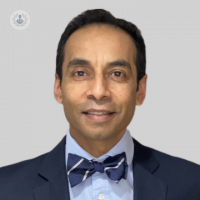Skin cancer detection: Recognising suspicious moles
Written by:Moles are small, coloured growths that can appear anywhere on the skin. While they are usually harmless, changes in size, shape or colour could indicate skin cancer, the most common type of cancer in the UK.
Dr Ravi Ratnavel, renowned consultant dermatologist, provides an expert overview of suspicious moles, explaining how often people should check their moles, what a dermatologist is looking for during a mole screening and what happens if a cancerous mole is found.

Identifying the different types of moles
Distinguishing harmless from medically serious moles can be challenging without proper expertise and experience. Easily managed, most of these suspicious moles prove to be benign seborrheic keratoses (similar to warts) that can be treated with cryotherapy using liquid nitrogen. Local anaesthetic can remove those moles that require pathological examination.
Regularly examining your skin with a mirror, especially in areas with moles or skin lesions, is important. It is also worth having an examination for skin cancer done by a specialist if you develop new moles whose size, colour and appearance look different from any of your existing moles.
Checking moles at home and in a clinic
Looking for an increase in size and a change of colour, people with more than five moles that are larger than 1cm in diameter should self-examine every two months. Examination can be done with home digital photographs or a mole monitoring app, which are both useful tools.
People should see a dermatologist in a clinic if:
- They have more than 10 moles which vary in size and appearance
- The diameter, size or colour of an individual mole has changed
- They have a past history and a family history of skin cancer
What can patients expect during a mole screening
A dermatologist will perform a clinical history relevant to skin cancer before examining the patient’s entire body. The amount of visible sun damage and education in regards to change will determine the medical guidance given, notifying future medical care. Thus, bringing timeline photographs of worrying moles or non-healing skin lesions to the consultation can be helpful. Cameras in modern mobile phones have turned out to be as effective as clinic mole mapping systems.
Making an assessment of photodamage, a dermatologist will look for asymmetry, a variation in pigmentation or irregular borders, size and shape of moles. In addition to these clinical signs, a dermatologist will also evaluate any non-healing lesions in the body which could be indicative of skin malignancy.
Using a magnifying lens and a dermatoscope, a dermatologist will carry out closer examination of any unusual moles and/or lesions that are found during the mole screening. These may reveal skin cancer or unrelated skin conditions that also require medical attention.
Finding a suspicious or cancerous mole
If a mole appears to be suspicious or cancerous, an initial excisional biopsy which removes the entire lesion, will be recommended. Using local anaesthesia, this procedure will be performed while the patient is awake, leaving a small wound with sutures or skin stitches that will need aftercare.
Dr Ravi Ratnavel is a renowned consultant dermatologist who specialises in all aspects of dermatology, including skin cancer, hair, skin and nail disorders, acne and suspicious moles. If you’re concerned about the aspect of your mole(s) and would like to seek expert assessment, don’t hesitate to visit Dr Ratnavel’s Top Doctors profile today.


